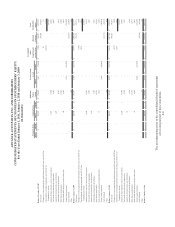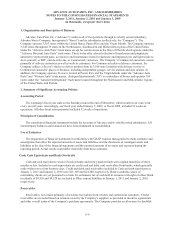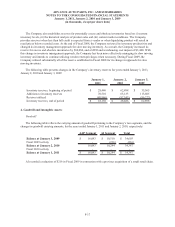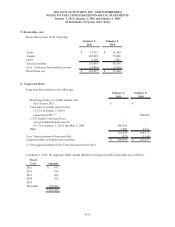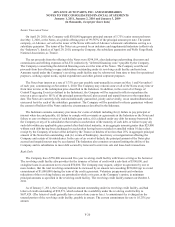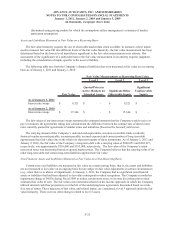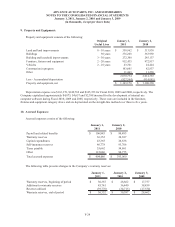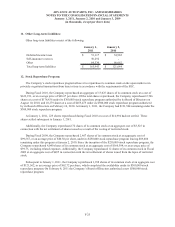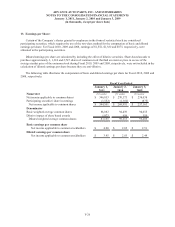Advance Auto Parts 2010 Annual Report Download - page 70
Download and view the complete annual report
Please find page 70 of the 2010 Advance Auto Parts annual report below. You can navigate through the pages in the report by either clicking on the pages listed below, or by using the keyword search tool below to find specific information within the annual report.
ADVANCE AUTO PARTS, INC. AND SUBSIDIARIES
NOTES TO THE CONSOLIDATED FINANCIAL STATEMENTS
January 1, 2011, January 2, 2010 and January 3, 2009
(in thousands, except per share data)
.
F-16
In December 2009, the FASB issued ASU No. 2009-16, “Transfers and Servicing (Topic 860) Accounting for
Transfers of Financial Assets,” which amends the ASC for the issuance of SFAS No. 166, “Accounting for
Transfers of Financial Assets – an amendment of FASB Statement No. 140.” The amendments in this ASU clarify
the requirements for isolation and limitations on portions of financial assets that are eligible for sale accounting and
require enhanced disclosures about the risks that a transferor continues to be exposed to because of its continuing
involvement in transferred financial assets. ASU 2009-16 is effective for the Company’s fiscal year beginning after
November 15, 2009. The adoption of ASU 2009-16 had no impact on the Company’s financial statements.
3. Inventories, net:
Merchandise Inventory
The Company uses the LIFO method of accounting for approximately 95% of inventories at January 1, 2011
and January 2, 2010, respectively. The Company’s overall costs to acquire inventory for the same or similar
products have generally decreased historically as the Company has been able to leverage its continued growth.
Additionally, the Company’s inventory costs have decreased in recent years as a result of the Company’s execution
of merchandise strategies and realization of supply chain efficiencies. As a result of utilizing LIFO, the Company
recorded a reduction to cost of sales of $29,554 and $16,040 for Fiscal 2010 and Fiscal 2009, respectively. The
Company recorded an increase to cost of sales of $12,555 for Fiscal 2008 primarily due to commodity inflation
experienced in Fiscal 2008.
Product Cores
The remaining inventories are comprised of product cores, the non-consumable portion of certain parts and
batteries, which are valued under the first-in, first-out ("FIFO") method. Product cores are included as part of the
Company’s merchandise costs and are either passed on to the customer or returned to the vendor. Because product
cores are not subject to frequent cost changes like the Company’s other merchandise inventory, there is no material
difference when applying either the LIFO or FIFO valuation method.
Inventory Overhead Costs
Purchasing and warehousing costs included in inventory, at FIFO, at January 1, 2011 and January 2, 2010, were
$103,989 and $104,761, respectively.
Inventory Balances and Inventory Reserves
Inventory balances at year-end for Fiscal 2010 and Fiscal 2009 were as follows:
January 1, January 2,
2011 2010
Inventories at FIFO, net 1,737,059$ 1,534,610$
Adjustments to state inventories at LIFO 126,811 97,257
Inventories at LIFO, ne
t
1,863,870$ 1,631,867$
Inventory quantities are tracked through a perpetual inventory system. The Company uses a cycle counting
program in all distribution centers and PDQ®s to ensure the accuracy of the perpetual inventory quantities of both
merchandise and product core inventory. For our retail stores, the Company completes physical inventories in
addition to other targeted inventory counts to ensure the accuracy of the perpetual inventory quantities of both
merchandise and core inventory in these locations. The Company establishes reserves for estimated shrink based on
results of completed physical inventories and other targeted inventory counts in its retail stores, results from recent
cycle counts in its distribution centers and historical and current loss trends.


